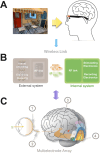Advances and challenges in the development of visual prostheses
- PMID: 39446886
- PMCID: PMC11616817
- DOI: 10.1371/journal.pbio.3002896
Advances and challenges in the development of visual prostheses
Abstract
The past 20 years have witnessed significant advancements in the field of visual prostheses, with developments spanning from early retinal implants to recent cortical approaches. This Perspective looks at some of the remaining challenges to achieve the ambitious clinical goals that these technologies could enable.
Copyright: © 2024 Fernandez, Robles. This is an open access article distributed under the terms of the Creative Commons Attribution License, which permits unrestricted use, distribution, and reproduction in any medium, provided the original author and source are credited.
Conflict of interest statement
The authors have declared no competing interest exist.
Figures

References
-
- da Cruz L, Coley BF, Dorn J, Merlini F, Filley E, Christopher P, et al.. The Argus II epiretinal prosthesis system allows letter and word reading and long-term function in patients with profound vision loss. Br J Ophthalmol. 2013;97(5):632–636. Epub 2013/02/22. doi: 10.1136/bjophthalmol-2012-301525 . - DOI - PMC - PubMed
-
- Edwards TL, Cottriall CL, Xue K, Simunovic MP, Ramsden JD, Zrenner E, et al.. Assessment of the Electronic Retinal Implant Alpha AMS in Restoring Vision to Blind Patients with End-Stage Retinitis Pigmentosa. Ophthalmology. 2018;125(3):432–443. Epub 20171027. doi: 10.1016/j.ophtha.2017.09.019 ; PubMed Central PMCID: PMC5818267. - DOI - PMC - PubMed
-
- Strickland E, Harris M. What happens when a bionic body part becomes obsolete?: blind people with second sight’s retinal implants found out. IEEE Spectrum. 2022;59(3):24–31.
MeSH terms
LinkOut - more resources
Full Text Sources
Miscellaneous

